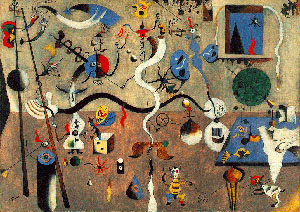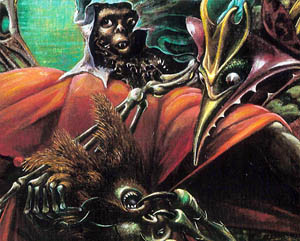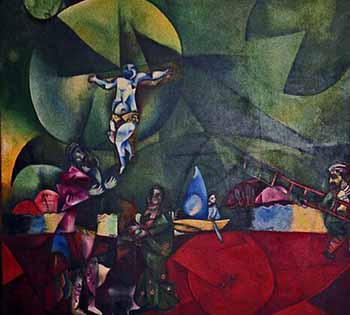 |
Art & Architecture
Esoteric Characteristics of Modern Art
Cunha Alvarenga
“Fair is foul, and foul is fair” said the witches of Macbeth (Act 1, Scene 1). Centuries later, referring to beauty, Picasso stated: “This is a word that does not have any meaning for me.” (1) Modern art disengages itself, therefore, from beauty and speaks a different language. Many naive persons imagine they can understand and appreciate modern art following the criteria of common sense. This is a mistake.

Surrealist Miro called for the release of subconscious to show contempt for traditional beauty |
An enormous quantity of ink has been used to write justifications and eulogies of modern art from the Catholic point of view. Although much has been written, nothing has been said because either the critics do not understand what they are seeing and saying or they understand the premises of modern art but are intentionally obscure not to reveal its full agenda. Indeed, those initiated into its occult purposes are well aware of the inroads the Revolution has made in the artistic sector but do not want to unveil it to the eyes of the public.
The role of true art
Beauty is an attribute of being. Truth, goodness and beauty are essential attributes of being. These attributes are inter-related, that is, what is true is also good and beautiful, what is good is true and beautiful, and what is beautiful is good and true. Since everything that exists is ontologically true, beauty should appear more often than it does now in our creation polluted by evil and sin.
God created us in beauty insofar as He created us in being. At the end of His work of creation He saw that everything was beautiful and good (Gen 1:31). Without the sins of the Angels and men, without this change in the divine order, error, evil and ugliness would have no practical meaning.

God created the world in beauty and order |
The order and harmony of universe have a perennial beauty. Beauty is not supposed to appear by chance, but would be present in everything if the original plan of God had been followed. There are different types of beauties that correspond to the different kinds of being: the physical, intellectual, moral and divine beings. The role of art should be to reveal the essential attributes of being as much as possible. Art should strive, Pius XII teaches, “to make the reflection of divine light smile over mankind … to help man to love everything that is true, pure, just and holy.” (2)
Something is not entirely beautiful unless it is fully inserted into the divine order, which is the only way for being to fulfill itself and reach its plenitude. Ugliness, falsehood and evil represent deficiencies of being. If we were to define absolute ugliness, we would say it is sin, the denial of divine order, the absence of being.
Modern art, esotericism and Pantheism
This philosophical base gives Catholics the criteria to judge beauty in its full dimension, which is a moral dimension, since Morals is the science of the good. Ethics and Aesthetics complement each other, seeking the fulfillment of God’s plan in creation.
These principles, however, mean nothing to the artists of modern art. They speak a different language. For the surrealists, for example, “art is nothing but a means to access the surreal.” If we were to ask a surrealist artist what exactly the surreal is, he would not have a coherent answer. Thus, we are obliged to take an indirect approach to find out what it is.
Marcel Raymond considers that “of all the philosophies, the one most suitable to surrealism is esotericism [the science of the occult, of secret doctrines] – transmitted and enriched by a centuries-old tradition. The presentiment of a surreal universe – which absorbs the external and internal, the objective and subjective, in their experience of the death of sensibility – seems to be the normal consequence of the latent mysticism of surrealism and its rejection of reality.”

The Temptation of St. Anthony by Dadaist Max Ernst |
The French Surrealist artist Georges Buraud says: “Surrealism is a form of esotericism, a revival of a verbal and graphic magic using new methods or the old practices re-baptized by a new poetry. … Surrealism is inspired by magic. This is the reason for its influence, its suggestive force.” (3)
Behind Surrealism is Pantheism, which seeks the fusion of everything into the Great All. While we can say that true art is directed toward God, surrealism and modern art are directed toward the Devil.
There are two tendencies in surrealism: First, one that tries to subvert the reality of creation, and second, one that tries to express the mystery of the subconscious. As it develops those different tendencies, the surrealists make use of dreams, madness, magic, meta-psychicism, the libido, the savage instinct and automatism. They use components of these different fields without reservations under the pretext that the artist must be liberated from of any bonds to morals or logic.
Such irrational and immoral aberrations are not exclusive to surrealism. We also find them, with slight variations, in cubism, expressionism, Dadaism, futurism, abstractionism and other sub-branches of this artistic kabala.
Modern art & Modernism
Modern art infiltrated the Catholic Church with the esoteric and extremely suspicious “sacred art” as part of the movement of Modernism. At the same time, we should note, other infiltrations were also taking place in the Church.

Crucifixion by Marc Chagall |
Under the general title of Modernism, we saw the rebirth of Gnosticism. “The sect of the Gnostics was also revived, and in 1893 it became the Gnostic church and was established in France by Fabre des Essarts in 1906. The Gnostics look for an esoteric common denominator that supposedly exists in every cult. For this purpose they study spiritism, hypnotism and magic. They try to explain the world without a Creator and end by professing an immanentist Pantheism.
Along the same lines, the Gnostics try to link the esotericism of the ancient Greek philosophers to the hermeticism of the Middle Ages, supposing it to underlay the doctrines of the Templars Knights, the Rosicrucians and the Freemasons.
Their pontiff is Albert Journet, who boasts to be the incontestable chief of modernist Catholics and aims to accomplish what he calls a Messianic Harmony. This would be a synthesis between the Church and the modern world, one that incorporates modern truths to Catholic doctrine. (4)
Thus we believe modern art must be studied from a broader perspective, as part of the far-ranging movement called Modernism.
Toynbee considers futurism, also a part of modern art, as authentic Satanism. Gaston Bardet explains how to track Satanism in the new religious art: “To demonstrate the Satanism of modern sacred art, we should apply the Marial test.” This means that we should look at how modern art is representing Our Lady to know where it is heading.
Applying this test, we could ask whether the Virgin at the foot of the Cross in the Crucifixion by Marc Chagall moves us to serve God or the Devil. Another example that shows the perversion of modern art is the book The Immaculate Conception by André Breton and Paul Eluard.
Continued
1. Apud René Huygue, Conteporains, p. 61.
2. Pius XII, Allocution to the International Congress of Christian Art, September 1950.
3. Georges Buraud, “Les magies de l’ssoterism nouveau,” Etudes Carmelitaines.
4. Dictionnaire Apologétique de Foi Catholique, ed. by A. d’Alés, vol. II, p.123.

Published in Catolicismo n. 31, July, 1953
Translated and adapted by TIA desk
Posted June 24, 2011

Related Topics of Interest
 Vertical versus Circular Architecture Vertical versus Circular Architecture
 Medieval Cathedrals & Modern Churches Medieval Cathedrals & Modern Churches
 Reading Medieval Architecture Reading Medieval Architecture
 Stained Glass: Light, Colors & Symbols Stained Glass: Light, Colors & Symbols
 Tepee Churches Tepee Churches
 Marvelous Continuity and Shocking Change Marvelous Continuity and Shocking Change
 Churches of Hell Churches of Hell
 The Babel Tower Governing Europe The Babel Tower Governing Europe
 Pagan and Christian Gnosis Pagan and Christian Gnosis

Related Works of Interest
|
|
Art & Architecture | Hot Topics | Home | Books | CDs | Search | Contact Us | Donate

© 2002-
Tradition in Action, Inc. All Rights Reserved
|
 |

|